Study on Outdoor Thermal Comfort of Commercial and Residential Mixed-Use Blocks in Hot and Humid Climates: Taking Guangzhou, China as an Example
Abstract
1. Introduction
2. Materials and Methods
2.1. Climate and Location
2.2. Block Conditions
2.3. Survey Plan
2.3.1. Determination of Thermal Comfort Indicators
2.3.2. Measurement of Thermal Environment
2.3.3. Collection of Individual Data
2.3.4. Survey of Subjective Questionnaire
2.4. Data Analysis
3. Results
3.1. Values of Thermal Environment
3.2. Values of Individual Data
3.3. Values of Subjective Questionnaire
3.4. The Relationship Between Indicators of Thermal Environment and Subjective Perception
3.5. The Connection Between Thermal Environment, Subjective Sensation, and Subjective Preference
3.6. Connection Between Thermal Environment and Subjective Acceptability
4. Discussion
4.1. Impact of Climatic Factors on Thermal Comfort
4.2. Effect of Urban Morphology on Thermal Comfort
4.3. Suggestion for Improving Thermal Comfort in Mixed-Use Blocks
- (1)
- Street height-to-width ratio optimization: A desirable thermal environment and enhanced user comfort can be achieved when the street height-to-width ratio exceeds 0.65. Therefore, the street width should be appropriately increased while reducing the height of buildings on both sides. Based on the analysis of the relationship between block height-to-width ratio and thermal comfort in this study, the optimal ratio for vehicle lanes is 0.65–1.4. This range reduces wake interference according to Niachou K’s research, enhances airflow stability, and improves subjective comfort. Additionally, pedestrian walkways should maintain a ratio greater than 0.65 to facilitate stable air circulation and increase wind speed perception. As demonstrated in this study, block B with a 1.4:1 ratio (exceeding 0.65) provided significantly higher comfort levels compared to block D with a 0.3:1 ratio.
- (2)
- Street network density enhancement: High-density street networks improve ventilation efficiency and alleviate subjective thermal stress. According to this study, contemporary blocks should aim to increase their road network density to modern block levels. Statistical results show that modern blocks A and B had densities exceeding 12 streets/km2, while contemporary blocks C and D had densities between 8 and 12 streets/km2. Block B with high-density streets demonstrated optimal ventilation performance: despite high relative humidity (up to 73.8%), its wet sensation index remained low (1.0), as shown in Figure 13.
- (3)
- Strategic street orientation planning: Street orientation significantly affects air velocity and thermal comfort by interacting with prevailing wind directions. Streets should preferably align with dominant winds (e.g., east-west orientation for easterly winds), especially in areas with height-to-width ratios exceeding 0.65. Avoiding north–south orientations conflicting with dominant winds is crucial. The orientation design of modern block B in this study promoted air penetration, effectively improving perceived wind comfort.
4.4. Study Limitations and Suggestions for Future Research
5. Conclusions
- (1)
- The mean value of air temperature was 31.8 °C and the relative humidity was 65.8% in four mixed-use blocks, displaying the climate feature of high temperature and high humidity, highlighting challenges in achieving thermal comfort standards.
- (2)
- Although the subjective sensation and subjective preference differed among the four mixed-use blocks, they exhibited corresponding patterns. However, the average subjective acceptability was not affected by subjective sensations and preferences, presenting a “neutral” value in most blocks.
- (3)
- The indicators of thermal environment and subjective perception did not indicate simple linear relationships, as they were influenced by the interplay of various environmental factors, spatial layout, and psychological cognition. For instance, blocks B and D had comparable average temperatures but showed notable differences in thermal sensation.
- (4)
- Multiple linear regression analysis revealed that air temperature, mean radiant temperature, and relative humidity were the critical factors affecting subjective acceptability across the four blocks.
- (5)
- Urban morphology impacted outdoor thermal comfort substantially, where three critical morphological determinants—texture density, street height-to-width ratio (D/H), and orientation strategy—played pivotal regulatory roles.
Author Contributions
Funding
Data Availability Statement
Acknowledgments
Conflicts of Interest
References
- Hirt, S.A. Rooting out mixed use: Revisiting the original rationales. Land Use Policy 2016, 50, 134–147. [Google Scholar] [CrossRef]
- Campbell, S. Green cities, growing cities, just cities? Urban planning and the contradictions of sustainable development. J. Am. Plan. Assoc. 1996, 62, 296–312. [Google Scholar] [CrossRef]
- Jacobs, J. The Death and Life of Great American Cities; Random House: New York, NY, USA, 1961. [Google Scholar]
- Wickersham, J. Jane Jacobs’s Critique of Zoning: From Euclid to Portland and Beyond. Boston Coll. Environ. Aff. Law Rev. 2001, 28, 547–563. [Google Scholar]
- Javadi, R.; Nasrollahi, N. Urban green space and health: The role of thermal comfort on the health benefits from the urban green space: A review study. Build. Environ. 2021, 202, 108039. [Google Scholar] [CrossRef]
- Liu, W.; Zhang, Y.; Deng, Q. The effects of urban microclimate on outdoor thermal sensation and neutral temperature in hot-summer and cold-winter climate. Energy Build. 2016, 128, 190–197. [Google Scholar] [CrossRef]
- Zheng, X.; Chen, L.; Yang, J. Simulation framework for early design guidance of urban streets to improve outdoor thermal comfort and building energy efficiency in summer. Build. Environ. 2023, 228, 109815. [Google Scholar] [CrossRef]
- Chen, L. Studies of thermal comfort and space use in an urban park square in cool and cold seasons in Shanghai. Build. Environ. 2015, 94, 644–653. [Google Scholar] [CrossRef]
- Huang, K.T. Impact of street canyon typology on building’s peak cooling energy demand: A parametric analysis using orthogonal experiment. Energy Build. 2017, 154, 448–464. [Google Scholar] [CrossRef]
- Alijani, S.; Pourahmad, A.; Nejad, H.H.; Ziari, K.; Sodoudi, S. A new approach of urban livability in Tehran: Thermal comfort as a primitive indicator. Case study, district 22. Urban Clim. 2020, 33, 100656. [Google Scholar] [CrossRef]
- Rundell, K.W. Effect of air pollution on athlete health and performance. Br. J. Sports Med. 2012, 46, 407–412. [Google Scholar] [CrossRef]
- Kenney, W.L.; Wolf, S.T.; Dillon, G.A.; Berry, C.W.; Alexander, L.M. Temperature regulation during exercise in the heat: Insights for the aging athlete. J. Sci. Med. Sport 2020, 24, 739–746. [Google Scholar] [CrossRef] [PubMed]
- ANSI/ASHRAE Standard 55-2023; Thermal Environmental Conditions for Human Occupancy. American Society of Heating, Refrigerating and Air Conditioning Engineers, Inc.: Atlanta, GA, USA, 2023.
- Guo, T.; Lin, Z.; Zhao, Y.; Fang, Z.; Fan, Y.; Zhang, X.; Yang, J.; Li, Y. Investigation and optimization of outdoor thermal comfort in elementary school campuses: Example from a humid-hot area in China. Build. Environ. 2024, 248, 111055. [Google Scholar] [CrossRef]
- Khalili, S.; Fayaz, R.; Zolfaghari, S.A. Analyzing outdoor thermal comfort conditions in a university campus in hot-arid climate: A case study in Birjand, Iran. Urban Clim. 2022, 43, 101128. [Google Scholar] [CrossRef]
- Huang, Z.; Cheng, B.; Gou, Z.; Zhang, F. Outdoor thermal comfort and adaptive behaviors in a university campus in China’s hot summer-cold winter climate region. Build. Environ. 2019, 165, 106414. [Google Scholar] [CrossRef]
- Li, Z.; Zhou, L.; Hong, X.; Qiu, S. Outdoor thermal comfort and activities in urban parks: An experiment study in humid subtropical climates. Build. Environ. 2024, 253, 111361. [Google Scholar] [CrossRef]
- Bian, G.; Gao, X.; Zou, Q.; Cheng, Q.; Sun, T.; Sha, S.; Zhen, M. Effects of thermal environment and air quality on outdoor thermal comfort in urban parks of Tianjin, China. Environ. Sci. Pollut. Res. 2023, 30, 97363–97376. [Google Scholar] [CrossRef]
- Wei, D.; Yang, L.; Bao, Z.; Lu, Y.; Yang, H. Variations in outdoor thermal comfort in an urban park in the hot-summer and cold-winter region of China. Sustain. Cities Soc. 2022, 77, 103535. [Google Scholar] [CrossRef]
- Su, Y.; Wang, C.; Li, Z.; Meng, Q.; Gong, A.; Wu, Z.; Zhao, Q. Summer outdoor thermal comfort assessment in city squares-A case study of cold dry winter, hot summer climate zone. Sustain. Cities Soc. 2024, 101, 105062. [Google Scholar] [CrossRef]
- Manavvi, S.; Rajasekar, E. Assessing thermal comfort in urban squares in humid subtropical climate: A structural equation modelling approach. Build. Environ. 2023, 229, 109931. [Google Scholar] [CrossRef]
- Jamei, E.; Rajagopalan, P.; Seyedmahmoudian, M.; Jamei, Y. Review on the impact of urban geometry and pedestrian level greening on outdoor thermal comfort. Renew. Sustain. Energy Rev. 2016, 54, 1002–1017. [Google Scholar] [CrossRef]
- Lai, D.; Liu, W.; Gan, T.; Liu, K.; Chen, Q. A review of mitigating strategies to improve the thermal environment and thermal comfort in urban outdoor spaces. Sci. Total Environ. 2019, 661, 337–353. [Google Scholar] [CrossRef]
- Lin, J.; Brown, R.D. Integrating microclimate into landscape architecture for outdoor thermal comfort: A systematic review. Land 2021, 10, 196. [Google Scholar] [CrossRef]
- Shui, X.; Xiao, Y.; Chen, X.; Lei, Y. Study on the Function System of Internal Roads in Commercial and Residential Blocks in Urban Centers. Archit. Cult. 2019, 4, 153–154. [Google Scholar]
- Zhou, L.; Wang, C.; Zhen, F. Exploring and evaluating the spatial association between commercial and residential spaces using Baidu trajectory data. Cities 2023, 141, 104514. [Google Scholar] [CrossRef]
- Zhou, L.; Liu, M.; Zheng, Z.; Wang, W. Quantification of spatial association between commercial and residential spaces in Beijing using urban big data. Int. J. Geo-Inf. 2022, 11, 249. [Google Scholar] [CrossRef]
- Ma, J.; Gao, Y.; Lv, X. Renewal and Activation Strategy of Traditional Commercial and Residential Blocks in Old Town Regeneration: Taking Beimen Block of Yuncheng County as an Example. Archit. Cult. 2021, 2, 218–221. [Google Scholar]
- Zheng, W.; Huang, Y. A Study on the Functional Mixing Types and Distribution of Blocks Based on MXI Measures: The Case of Nanjing Old City Area. New Archit. 2024, 3, 136–141. [Google Scholar]
- Dai, M.; Wang, W.; Hu, C. Characteristics of Particulate Matter Distribution in Business and Residence Mixed Blocks and Influence on Building Layout-Taking Binhu Block in Hefei City as an Example. Hous. Sci. 2023, 43, 44–56. [Google Scholar]
- Monthly Element Statistics of Compilation for 30 Years (1991–2020). 2021. Guangzhou Weather. Available online: http://www.tqyb.com.cn/gz/climaticprediction/static (accessed on 23 March 2025).
- Zheng, L. Research on the Influence of Urban Geometric Morphological Factors on the Heat Island Effect in Guangzhou City. Master’s Thesis, Jinan University, Guangzhou, China, 2020. [Google Scholar]
- Huang, X.; Xun, Y.; Zhao, C.; Chen, G.; Guo, W. Comparative study on thermal comfort of sports buildings in hot and humid climates from the perspective of exercisers and non-exercisers. Build. Environ. 2023, 246, 110980. [Google Scholar] [CrossRef]
- JGJ/T347-2014; Standard of Test Methods for Thermal Environment of Building. Architecture & Building Press: Beijing, China, 2014.
- Nikolopoulou, M.; Baker, N.; Steemers, K. Improvements to the globe thermometer for outdoor use. Archit. Sci. Rev. 1999, 42, 27–34. [Google Scholar] [CrossRef]
- ISO 7726: 1998; Ergonomics of the Thermal Environment—Instruments for Measuring Physical Quantities. International Organization for Standardization: Geneva, Switzerland, 1998.
- ISO 7730: 2005; Ergonomics of the Thermal Environment-Analytical Determination and Interpretation of Thermal Comfort Using Calculation of the PMV and PPD Indices and Local Thermal Comfort Criteria. International Organization for Standardization: Geneva, Switzerland, 2005.
- Huang, X.; Chen, G.; Zhao, C.; Peng, Y.; Guo, W. Post occupancy evaluation of indoor environmental quality of sports buildings at hot and humid climate from the perspective of exercisers. Build. Environ. 2022, 226, 109760. [Google Scholar] [CrossRef]
- Talukdar, M.S.J.; Talukdar, T.H.; Singh, M.K.; Baten, M.A.; Hossen, M.S. Status of thermal comfort in naturally ventilated university classrooms of Bangladesh in hot and humid summer season. J. Build. Eng. 2020, 32, 101700. [Google Scholar] [CrossRef]
- Damiati, S.A.; Zaki, S.A.; Rijal, H.B.; Wonorahardjo, S. Field study on adaptive thermal comfort in office buildings in Malaysia, Indonesia, Singapore, and Japan during hot and humid season. Build. Environ. 2016, 109, 208–223. [Google Scholar] [CrossRef]
- Deevi, B.; Chundeli, F.A. Quantitative outdoor thermal comfort assessment of street: A case in a warm and humid climate of India. Urban Clim. 2020, 34, 100718. [Google Scholar] [CrossRef]
- Elnabawi, M.H.; Hamza, N.; Dudek, S. Thermal perception of outdoor urban spaces in the hot arid region of Cairo, Egypt. Sustain. Cities Soc. 2016, 22, 136–145. [Google Scholar] [CrossRef]
- Adunola, A.O. Evaluation of urban residential thermal comfort in relation to indoor and outdoor air temperatures in Ibadan, Nigeria. Build. Environ. 2014, 75, 190–205. [Google Scholar] [CrossRef]
- Humphreys, M. Field studies of thermal comfort compared and applied. Build. Serv. Eng. 1976, 44, 5–27. [Google Scholar]
- Lei, T.H.; Wang, F. Looking ahead of 2021 Tokyo Summer Olympic Games: How Does Humid Heat Affect Endurance Performance? Insight into physiological mechanism and heat-related illness prevention strategies. J. Therm. Biol. 2021, 99, 102975. [Google Scholar] [CrossRef]
- Vargas, N.T.; Chapman, C.L.; Johnson, B.D.; Gathercole, R.; Schlader, Z.J. Skin wettedness is an important contributor to thermal behavior during exercise and recovery. Am. J. Physiol. Soc. 2018, 315, 925–933. [Google Scholar] [CrossRef]
- Hayes, M.; Castle, P.C.; Ross, E.Z.; Maxwell, N.S. The influence of hot humid and hot dry environments on intermittent-sprint exercise performance. Int. J. Sports Physiol. Perform. 2014, 9, 387–396. [Google Scholar] [CrossRef]
- Jia, X.; Wang, J.; Zhu, Y.; Ji, W.; Cao, B. Climate chamber study on thermal comfort of walking passengers at different moving speeds. Build. Environ. 2022, 224, 109540. [Google Scholar] [CrossRef]
- Zhou, J.; Zhang, X.; Xie, J.; Liu, J. Effects of elevated air speed on thermal comfort in hot-humid climate and the extended summer comfort zone. Energy Build. 2023, 287, 112953. [Google Scholar] [CrossRef]
- Zhou, J.; Zhang, X.; Xie, J.; Liu, J. Occupant’s preferred indoor air speed in hot-humid climate and its influence on thermal comfort. Build. Environ. 2023, 229, 109933. [Google Scholar] [CrossRef]
- Jia, X.; Wang, J.; Zhu, Y.; Ji, W.; Cao, B. Cooling effect of elevated ambient air velocity on thermal comfort when sitting after walking. Build. Environ. 2022, 225, 109664. [Google Scholar] [CrossRef]
- Mihara, K.; Sekhar, C.; Tham, K.W.; Takemasa, Y.; Lasternas, B. Effects of temperature, air movement and initial metabolic rate on thermal sensation during transient state in the tropics. Build. Environ. 2019, 155, 70–82. [Google Scholar] [CrossRef]
- Ashihara, Y. The Aesthetic Townscape; The MIT Press: Cambridge, MA, USA, 1986. [Google Scholar]
- Fazia, A.; Helmut, M. Numerical Study on the Effects of Aspect Ratio and Orientation of an Urban Street Canyon on Outdoor Thermal Comfort in Hot and Dry Climate. Build. Environ. 2006, 41, 94–108. [Google Scholar]
- Niachou, K.; Livada, I.; Santamouris, M. Experimental Study of Temperature and Airflow Distribution inside an Urban Street Canyon during Hot Summer Weather Conditions. Part I: Air and surface temperature. Build. Environ. 2008, 43, 1383–1392. [Google Scholar] [CrossRef]
- Alfano, F.R.D.; Dell’Isola, M.; Ficco, G.; Palella, B.I.; Riccio, G. Small globes and pocket heat stress meters for WBGT and PHS evaluations. A critical analysis under controlled conditions. Build. Environ. 2022, 226, 109781. [Google Scholar] [CrossRef]
- Alfano, F.R.D.; Palella, B.I.; Riccio, G. The Role Of Measurement Accuracy On The Heat Stress Assessment According To ISO 7933: 2004. Environ. Health Risk IV 2007, 11, 115–124. [Google Scholar]



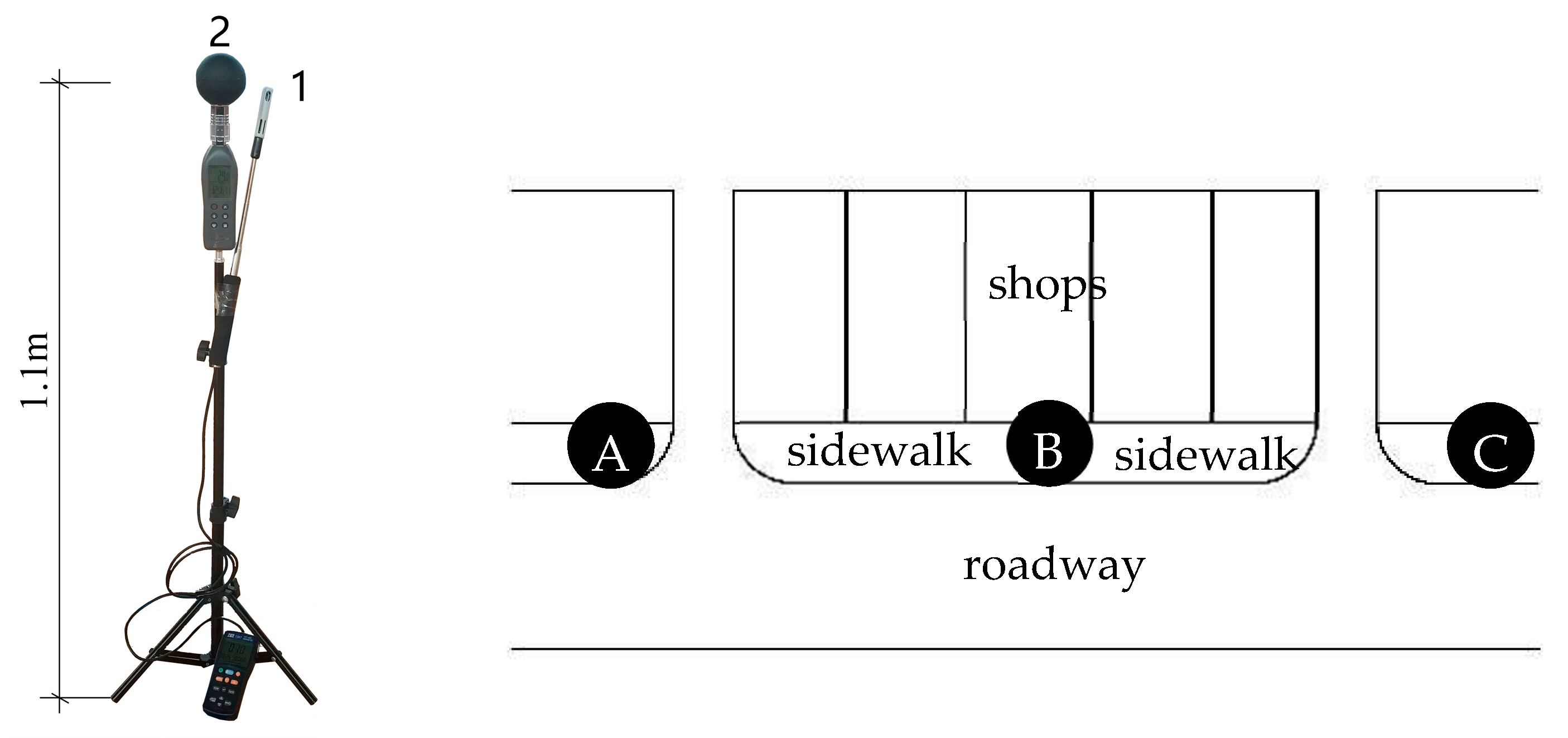

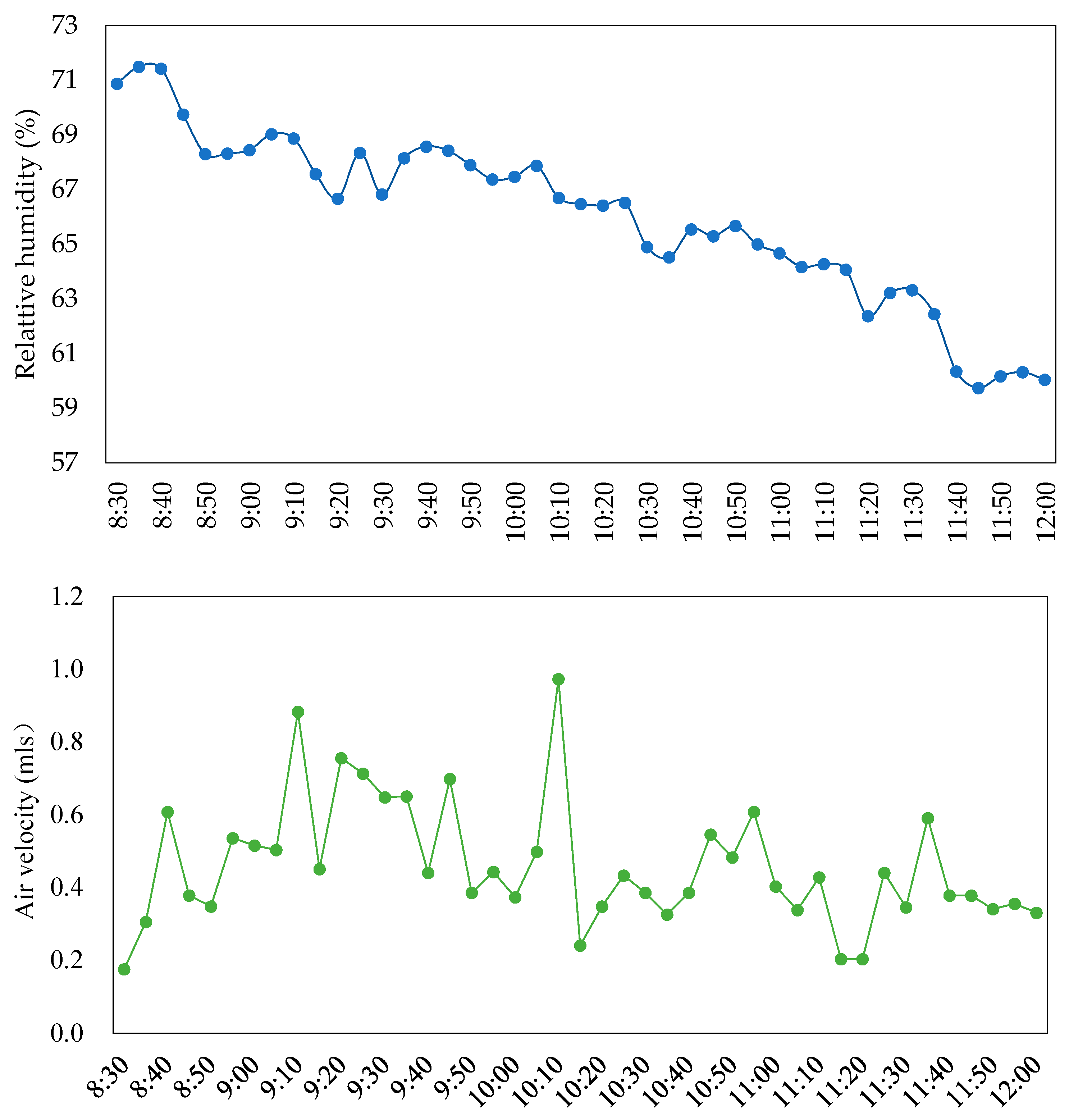


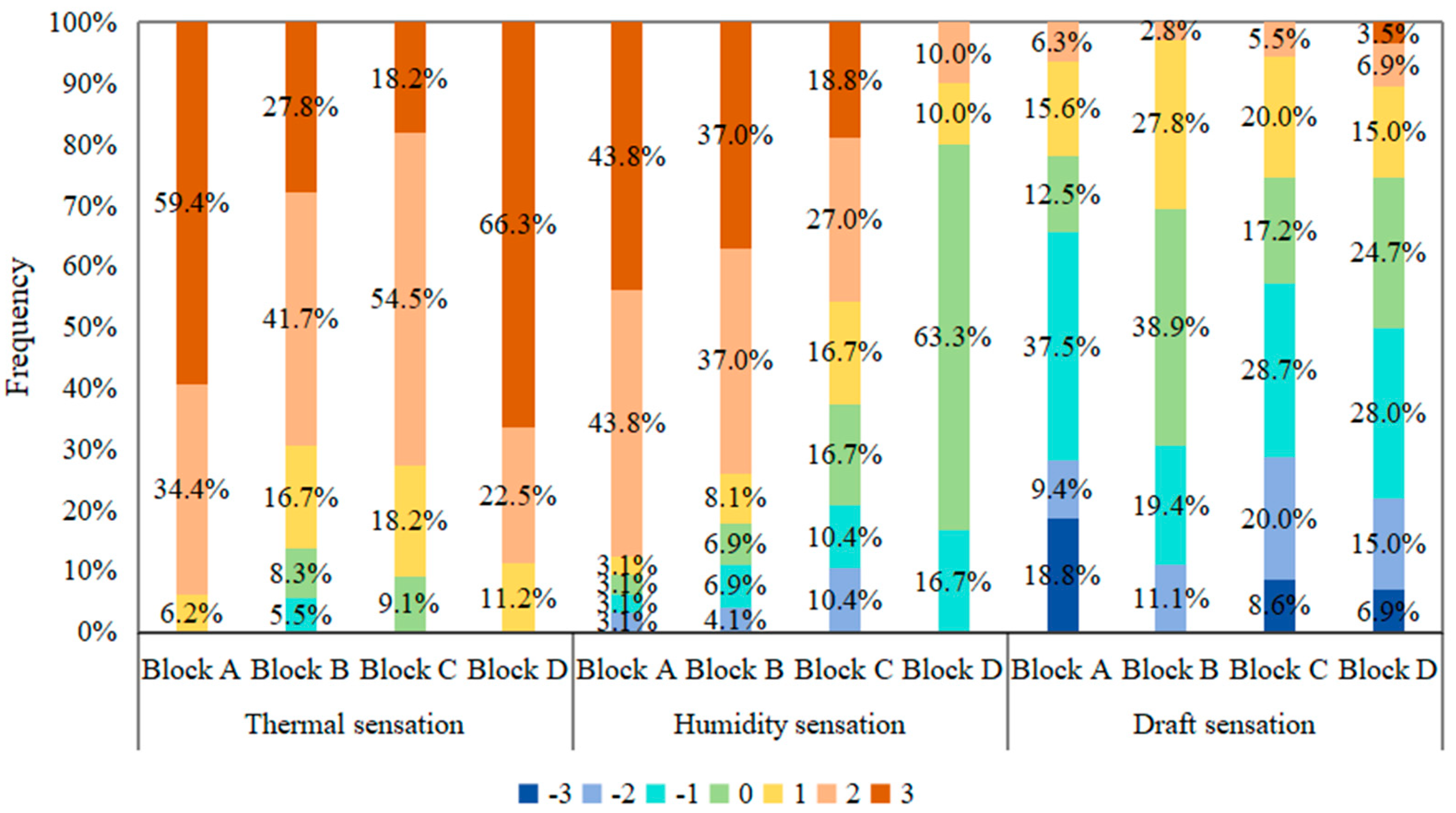
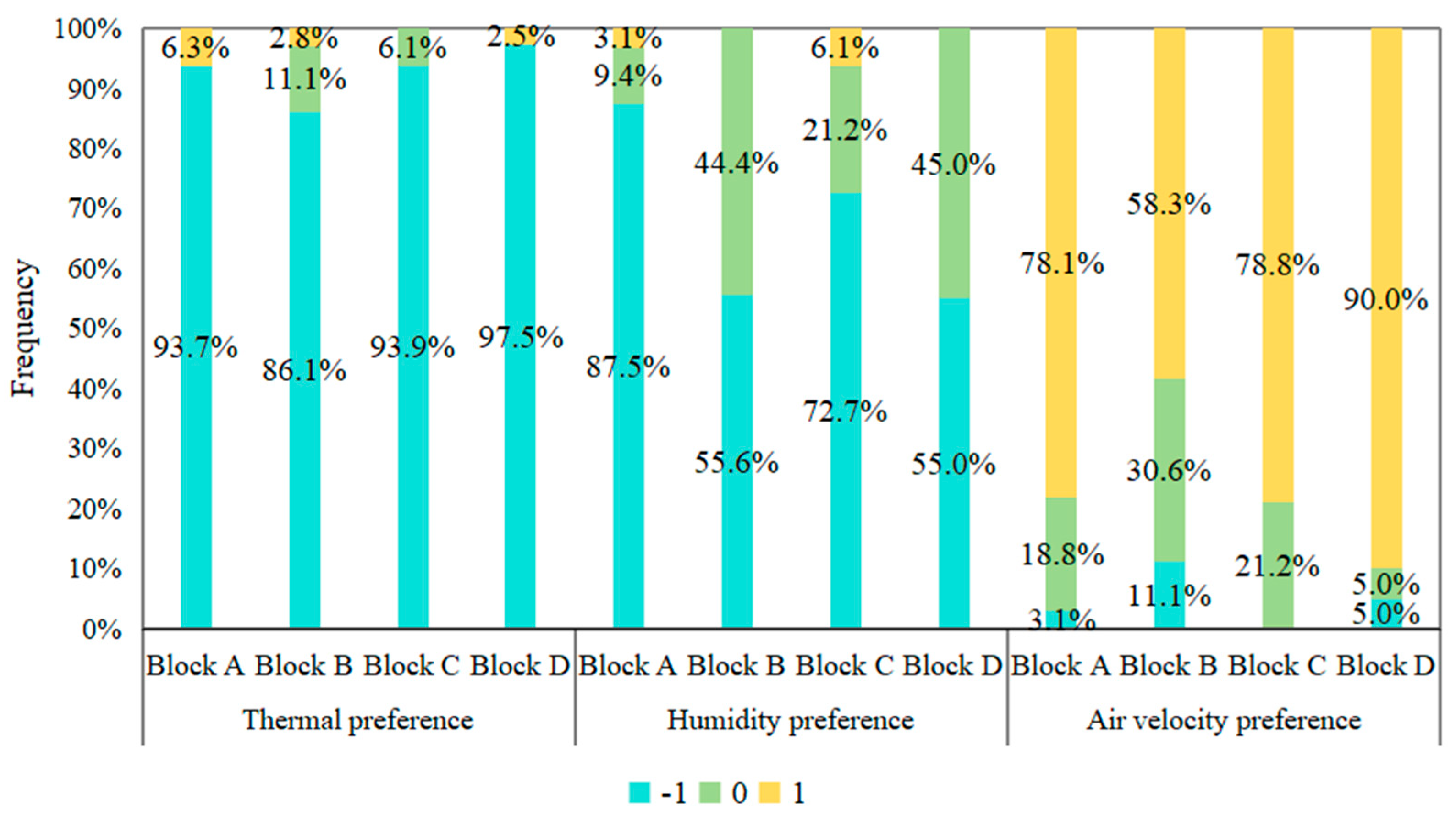

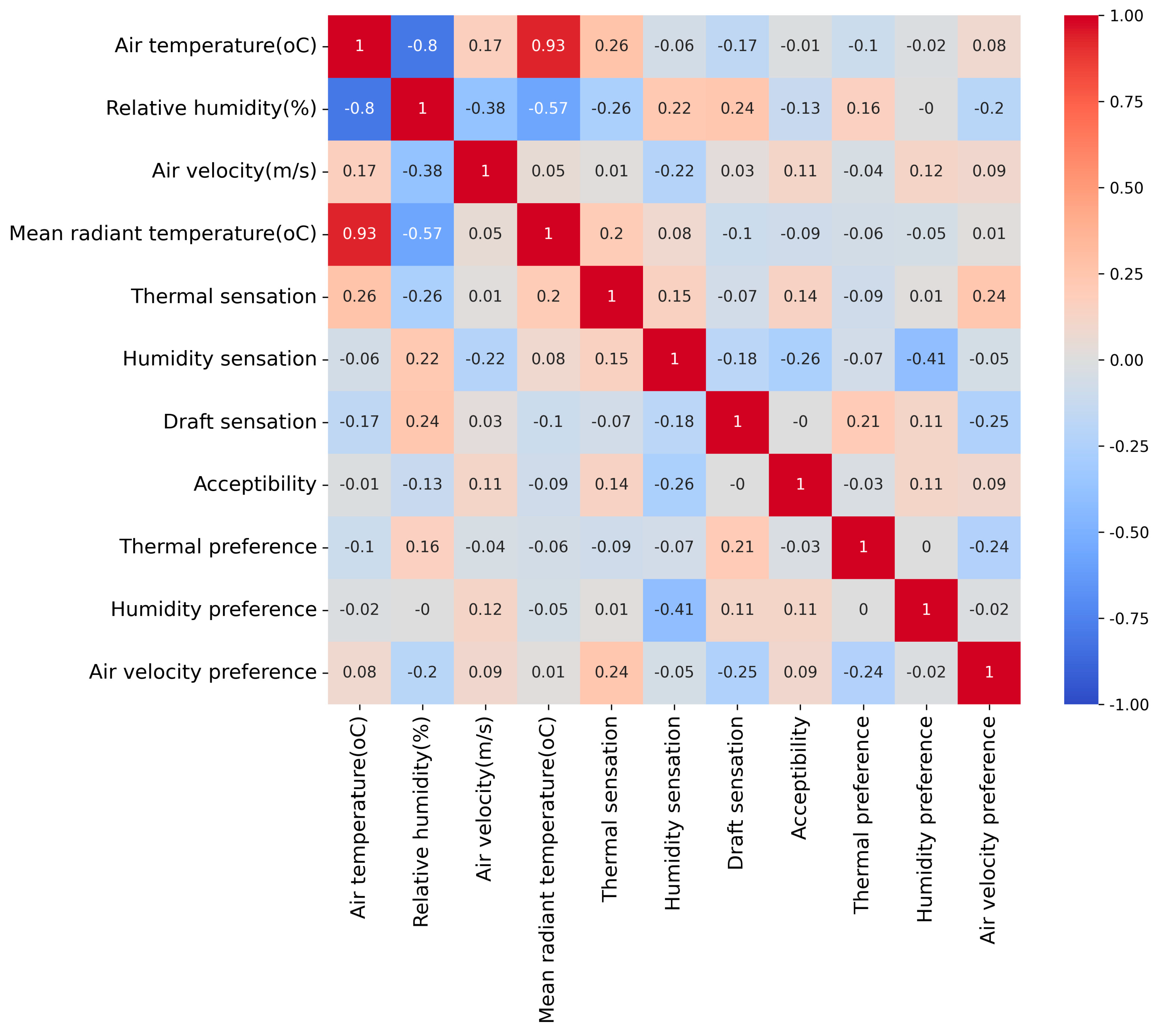


| Thermal Environment | Subjective Perception | Individual Data | ||
|---|---|---|---|---|
| Sensation | Preference | Acceptability | ||
| Air temperature (°C) | Thermal sensation | Thermal preference | Subjective acceptability | Metabolic rate Clothing insulation |
| Mean radiant temperature (°C) | ||||
| Relative humidity (%) | Humidity sensation | Humidity preference | ||
| Air velocity (m/s) | Draft sensation | Air velocity preference | ||
| No. | Device | Model | Testing Content | Title 3 |
|---|---|---|---|---|
| 1 | Hot-wire anemometer | TES-1341(TES Electrical Electronic Corp., Taiwan, China) | Air temperature Relative humidity Air velocity | ±0.4 °C ±3%RH ±3%rdg ± 1%FS |
| 2 | Globe thermometer | AZ-87786(AZ Instrument Corp., Taiwan, China) | Globe temperature | ±0.6 °C |
| Male | Female | |
|---|---|---|
| Number | 93 | 62 |
| Age | 16–78 (Average: 36) | 16–83 (Average: 36) |
| Duration of local residence (years) | ≥1 | ≥1 |
| Clothing | Shorts and trousers | Shorts, trousers and skirts |
| Behavior | Sitting, standing, and walking | Sitting, standing, and walking |
| Thermal Sensation | Humidity Sensation | Draft Sensation | Thermal Preference | Humidity Preference | Air Velocity Preference | Subjective Acceptability | |
|---|---|---|---|---|---|---|---|
| 3 | Hot | Very wet | Very strong | Very acceptable | |||
| 2 | Warm | Wet | Strong | Acceptable | |||
| 1 | Slightly warm | Slightly wet | Slightly strong | Warmer | Wetter | More | Slightly acceptable |
| 0 | Neutral | Neutral | Neutral | No change | No change | No change | Neutral |
| −1 | Slightly cool | Slightly dry | Slightly weak | Cooler | Drier | Less | Slightly unacceptable |
| −2 | Cool | Dry | Weak | Unacceptable | |||
| −3 | Cold | Very dry | Very weak | Very unacceptable |
| Maximum | Minimum | Mean | Standard Deviation | |
|---|---|---|---|---|
| Air temperature (°C) | 37.5 | 29.6 | 31.8 | 1.7 |
| Mean radiant temperature (°C) | 43.5 | 29.8 | 32.6 | 2.0 |
| Relative humidity (%) | 81.8 | 48.8 | 65.8 | 7.4 |
| Air velocity (m/s) | 2.29 | 0.01 | 0.48 | 0.41 |
| Subjective Perception | Average Value | ||||
|---|---|---|---|---|---|
| Block A | Block B | Block C | Block D | ||
| Sensation | Thermal sensation | 2.5 (Hot) | 1.7 (Warm) | 1.8 (Warm) | 2.5 (Hot) |
| Humidity sensation | 2.1 (Wet) | 1.0 (Slightly wet) | 0.8 (Slightly wet) | 0.4 (Neutral) | |
| Draft sensation | −0.8 (Slightly weak) | −0.1 (Neutral) | −0.8 (Slightly weak) | −0.9 (Slightly weak) | |
| Preference | Thermal preference | −0.9 (Cooler) | −0.8 (Cooler) | −0.9 (Cooler) | −1.0 (Cooler) |
| Humidity preference | −0.8 (Drier) | −0.6 (Drier) | −0.7 (Drier) | −0.6 (Drier) | |
| Air velocity preference | 0.8 (Stronger) | 0.5 (Stronger) | 0.8 (Stronger) | 0.9 (Stronger) | |
| Acceptability | Subjective acceptability | 0.3 (Neutral) | −0.3 (Neutral) | −0.4 (Neutral) | 1.3 (Slightly acceptable) |
| Indicator | B | p | VIF | Adjusted R2 | F |
|---|---|---|---|---|---|
| Air temperature | −0.182 | 0.001 * | 3.261 | 0.720 | 58.711 (p < 0.001) |
| Relative humidity | −0.061 | 0.004 * | 2.680 | ||
| Air velocity | 0.091 | 0.210 | 1.351 | ||
| Mean radiant temperature | 0.210 | 0.001 * | 3.812 | ||
| Constant | 2.543 | 0.012 | - |
| Block | D/H | Temperature Aspect | Humidity Aspect | Air Velocity Aspect | |||
|---|---|---|---|---|---|---|---|
| Air Temperature | Thermal Sensation | Relative Humidity | Humidity Sensation | Air Velocity | Draft Sensation | ||
| A | 2.0:1 | 33.4 | 2.5 | 66.7 | 2.1 | 0.38 | −0.8 |
| B | 1.4:1 | 31.9 | 1.7 | 73.8 | 1.0 | 0.25 | −0.1 |
| C | 0.6:1 | 32.4 | 1.8 | 61.4 | 0.8 | 0.72 | −0.8 |
| D | 0.3:1 | 32 | 2.5 | 61.6 | 0.4 | 0.58 | −0.9 |
Disclaimer/Publisher’s Note: The statements, opinions and data contained in all publications are solely those of the individual author(s) and contributor(s) and not of MDPI and/or the editor(s). MDPI and/or the editor(s) disclaim responsibility for any injury to people or property resulting from any ideas, methods, instructions or products referred to in the content. |
© 2025 by the authors. Licensee MDPI, Basel, Switzerland. This article is an open access article distributed under the terms and conditions of the Creative Commons Attribution (CC BY) license (https://creativecommons.org/licenses/by/4.0/).
Share and Cite
Xun, Y.; Huang, X.; Zeng, Q.; Ye, M.; Guo, Y. Study on Outdoor Thermal Comfort of Commercial and Residential Mixed-Use Blocks in Hot and Humid Climates: Taking Guangzhou, China as an Example. Energies 2025, 18, 2015. https://doi.org/10.3390/en18082015
Xun Y, Huang X, Zeng Q, Ye M, Guo Y. Study on Outdoor Thermal Comfort of Commercial and Residential Mixed-Use Blocks in Hot and Humid Climates: Taking Guangzhou, China as an Example. Energies. 2025; 18(8):2015. https://doi.org/10.3390/en18082015
Chicago/Turabian StyleXun, Yi, Xiaodan Huang, Qimin Zeng, Meilan Ye, and Yufeng Guo. 2025. "Study on Outdoor Thermal Comfort of Commercial and Residential Mixed-Use Blocks in Hot and Humid Climates: Taking Guangzhou, China as an Example" Energies 18, no. 8: 2015. https://doi.org/10.3390/en18082015
APA StyleXun, Y., Huang, X., Zeng, Q., Ye, M., & Guo, Y. (2025). Study on Outdoor Thermal Comfort of Commercial and Residential Mixed-Use Blocks in Hot and Humid Climates: Taking Guangzhou, China as an Example. Energies, 18(8), 2015. https://doi.org/10.3390/en18082015






